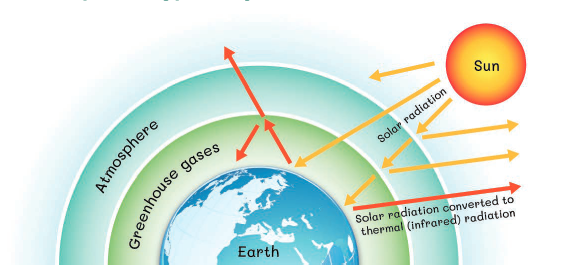What is Climate Change?
Climate change is different from changes in the weather. Weather can change from day to day and hour to hour, while climate is the average pattern of weather over a long time. Climate change is an alteration of the earth’s general weather conditions. The most prominent part of climate change is the rising temperature at the earth’s surface. Apart from increasing average temperature, climate change also includes changes in rainfall patterns and an increase in extreme weather events that lead to phenomena such as floods and droughts.
The Greehouse Effect
When the sun shines on Earth, some of its solar radiation (in the form of light energy) is reflected by Earth’s surface and the atmosphere. The rest of the solar radiation is absorbed by Earth’s surface and atmosphere and is converted to heat energy (infra-red radiation) that warms Earth. The infrared radiation is emitted from Earth’s surface again but not all of it escapes to outer space. Some of the radiation is absorbed and reemitted in all directions by greenhouse gas molecules. These gases act like a blanket that keep Earth’s surface and the lower atmosphere warm. This is called the natural greenhouse effect. Earth’s average temperature is 14°C, a comfortable temperature to sustain life. Without the greenhouse effect, so much infra-red radiation would be lost that Earth would be an icy -19°C. At these frigid temperatures, life as we know it would not be possible.

Greenhouse Gasses
The atmosphere is a layer of gases that surround Earth. These gases are mostly nitrogen (78%) and oxygen (21%). There are also smaller amounts of other gases present in the atmosphere. Among these gases are the greenhouse gases that are responsible for trapping the sun’s heat inside the atmosphere and keeping the planet warm. The most prominent greenhouse gases are water vapour (water in its gaseous phase), carbon dioxide, nitrous oxide and methane. When plants, animals and bacteria from long, long ago became fossilised, the carbon inside them became buried. Over the years, they turned into fossil fuels namely coal, oil and gas. Humans started burning large amounts of fossil fuels during the industrial revolution in the nineteenth century and this started releasing the ancient carbon back into the atmosphere. Humans have also been chopping down large forests, which reduces the Earth’s natural ability to absorb greenhouse gases. Agricultural practises, in particular, have increased the levels of methane and nitrous oxide in the atmosphere. With an increase in greenhouse gases, Earth loses less heat, causing warming of the planet. This warming effect is called global warming but it leads to various changes in climate all over Earth, even making some places colder.
Thank you to the Department of Environmental Affairs for partnering with us on this article

